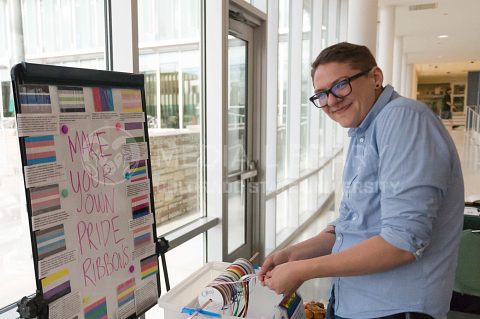Creating and inclusive environment which provides space for the complexity of identities in the classroom can improve social connection, create an optimal learning environment and improve student success and retention. CSU’s Teaching Effective Framework has additional ideas about Inclusive Pedagogy.
Think of inclusive education as an ongoing effort with three distinct but related goals (Waitoller & Kozleski, 2013): to more equitably distribute learning opportunities; to recognize and honor the differences among students; and to provide opportunities for marginalized groups “to represent themselves in decision-making processes”. As a conclusion to their meta-analysis of inclusive education research, Waitoller and Artiles (2013) argue that inclusivity should be treated more broadly than it has been previously. Rather than focusing on a unitary identity like “disabled” or “female,” for example, treat the question of inclusion in the classroom through a lens of intersectionality, considering all relevant identities and groups that have been historically marginalized in educational settings and how these identities overlap and impact people within oppressive systems.


Many higher education institutions in America were founded with money from the trading of enslaved people and built by enslaved individuals through forced labor (Harris, 2015). The land that many institutions of higher education were built on was taken from indigenous peoples, including CSU. Higher education has historically excluded people of color and contributed to white supremacy in America (Harris, 2015). Despite the passing of the Americans with Disabilities Act (ADA) and other legislation meant to enforce accessibility for disabled people, many campuses are not compliant and make accessing education difficult or impossible. It is important to acknowledge this history and current shortcomings in order to enable learning and change.
CSU’s Principles of Community outline a commitment to Inclusion, Integrity, Respect, Service, and Social Justice. CSU’s Land Acknowledgement states that “CSU is founded as a land-grant institution, and we accept that our mission must encompass access to education and inclusion. And, significantly, that our founding came at a dire cost to Native Nations and peoples whose land this University was built upon. This acknowledgment is the education and inclusion we must practice in recognizing our institutional history, responsibility, and commitment.” It is the responsibility of the administration, faculty, staff, students, and all of the CSU community to dedicate themselves to inclusivity and to acknowledge the oppressive history of our institution to actively combat oppression. This work can take place in and out of the classroom to impact the well-being and success of our students.

- Include CSU’s Principles of Community in your syllabus to reinforce the values of the CSU community.
- Consider beginning your course with a reading of CSU’s Land Acknowledgement
- Consider student needs when it comes to seating, visual/audio equipment, note taking, test taking, response opportunities, etc. Explicitly invite students to share their needs to foster their best learning in your classroom.
- Consider the accessibility of readings that you post. Can a screen reader access your PDFs?
- Use inclusive language and gender-neutral pronouns. Avoid terms such as “ladies and gentlemen” when referring to groups of people. Try “students” or “class” instead.
- Consider providing your pronouns to students when you introduce yourself and offer them the opportunity to do so as well, if they would like. Invite students to offer correction if misgendering has happened.
- Provide resource information in your syllabus or elsewhere. See University Resources.
- Be prepared to allow for and respond to different student responses within the content.
- Explicitly talk about mental health and well-being to normalize difficulties that students can experience due to challenges with diversity and inclusion, including micro aggressions, and social injustice fatigue.
- Listen to and appreciate a wide variety of responses, opinions, and experiences. Value the lived experience of students when they choose to share from their own experience.
- Consider the identities of the authors of readings, required or suggested in your classes and have readings by people of various races, ethnicities, religions, sexualities, gender identities, and other identities.
- Share the resources of CSU’s Student Diversity and Program Services on your syllabus and in your classes.
- Care for BIPOC students (Black Indigenous People of Color) includes an understanding how systemic racism affects all parts of life, including education. Learn about students’ needs and requests and CSU’s Race, Bias, and Equity Initiative.
- There are resources posted by the VP for Diversity’s Office. There is anti-racism literature and resources from CSU’s Black/African American Cultural Center or the Smithsonian’s National Museum of African American History & Culture.
- CSU’s Teaching Effective Framework has additional ideas for Inclusive Pedagogy
"Placeholder for quote about inclusive language and dialogue"
Inclusivity Resources:
- Office of the Vice President for Diversity
- The Institute for Learning and Teaching (TILT)
- Student Diversity Programs and Services (SDPS)
- Asian/Pacific American Cultural Center (APACC)
- Black/African American Cultural Center (BAACC)
- El Centro
- Native American Cultural Center (NACC)
- Pride Resource Center
- Student Disability Center
- Women and Gender Advocacy Center (WGAC)
- Place holder for Student Success link
- Assistive Technology Resource Center
- Race and Intersectional Studies in Education Equity Center
- Title IX
- Place holder for Intergroup Dialogue Program here
- CSU’s Faculty Institute for Inclusive Excellence and the Social Justice Institute
This is not a comprehensive list of diversity and inclusion resources on campus. For information about a specific topic, please contact the Office of the Vice President for Diversity